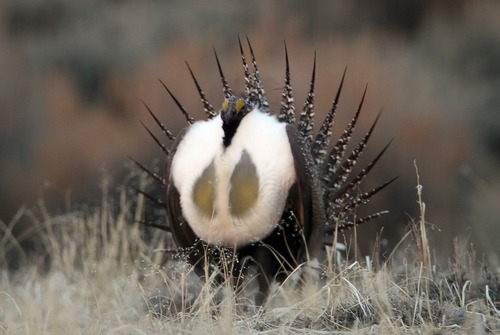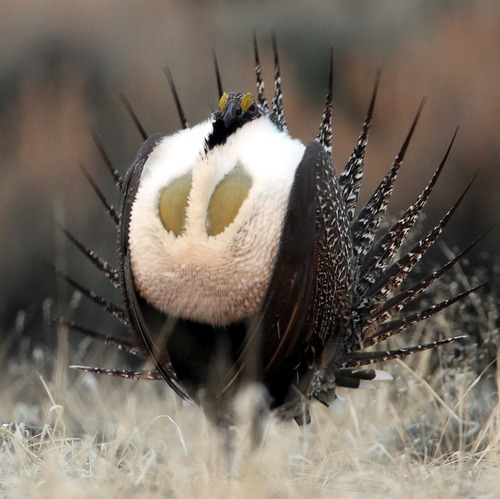This is an archived article that was published on sltrib.com in 2013, and information in the article may be outdated. It is provided only for personal research purposes and may not be reprinted.
The Bureau of Land Management on Friday will release a proposed plan to protect greater sage grouse on 4 million acres of federal land and subsurface mineral areas in Utah.
Among the many conservation measures envisioned, the plan would prohibit drilling within 4 miles of leks, the places where the chicken-sized bird stages its late-winter mating rituals. Other disturbances would be barred near leks, depending on the nature of the activity and time of year.
The BLM wants to amend land-use plans for several BLM resource areas that harbor habitat for the West's signature native bird, as well as for six national forests.
The goal is to build enough protection for the sage grouse to keep it off the endangered or threatened species list, said Quincy Bahr, the Utah BLM's sage grouse project leader.
The disappearance of sage grouse from much of their historic range has prompted federal officials to determine by the end of 2015 whether the bird warrants federal protection.
Such a listing would put a damper on energy development, grazing, recreation and a variety of other activities on the West's broad reach of federal lands. Habitat loss is the major threat to the bird's survival, arising from oil and gas drilling, livestock, off-road motor vehicle use and invasive plant species.
The BLM's proposed buffers around leks will please conservationists.
"Noise is something that is disturbing to sage grouse, human activities associated with roads and machinery," said Jim Catlin, a conservation biologist with the Wild Utah Project. "Those impacts don't always show changes in sage grouse populations right away. It could take several years."
The document the BLM is releasing is a four-volume draft Environmental Impact Statement that analyzes various alternatives for safeguarding grouse. The agency's "preferred" alternative was crafted in a partnership with the U.S. Forest Service and the U.S. Fish and Wildlife Service. It represents a middle ground between an alternative based on recommendations from the conservation community and another based on Utah's state conservation plan.
The public has 90 days to submit comment and BLM's final plan, to be completed by the end of next year, could be changed to incorporate elements of all the alternatives the agency studied.
The BLM preferred alternative deviates from the state plan most sharply when it comes to the size of buffer zones around "active" leks, which tend to be where the best brood habitat is found.
The birds occupy these places from late February to early June, during a time of year when they are most vulnerable to human disturbances.
While the state plan suggests development on top of leks, the BLM proposes a four-mile buffer zone for oil and gas development and transmission lines. Other disturbances, such as gravel pits and communication towers, get a one-mile buffer.
Conservationists recommend setting aside 2.2 million acres as special areas of environmental importance, lands that would carry specific rules limiting activity that could displace sage grouse. The BLM plan envisions allowing almost any activity in the bird's habitat outside lek-buffer areas, although only under certain circumstances.
For example, the plan identifies numerous priority areas, covering 2.8 million acres, where human-caused disturbance must be limited to 5 percent of the total sage grouse habitat regardless of land ownership. Once this threshold is breached, the BLM will not authorize new disturbances until enough habitat is restored to get the priority area back below the 5 percent limit. Habitat burned in a fire does not count toward the threshold. —
Sage grouse open houses
The Utah Bureau of Land Management is hosting a series of meetings, all set from 5:30 p.m. to 7:30 p.m., to provide information on its sage grouse conservation plan.
Nov. 19: Richfield, Snow College campus
Nov. 20: Cedar City, Heritage Center Festival Hall
Nov. 21: Panguitch, City Library
Dec. 4: Vernal, city offices
Dec. 5: Price, Carbon County Event Center
Dec. 10: Salt Lake City Public Library
Dec. 11: Randolph Senior Center gymnasium
Dec. 12: Snowville Elementary School





